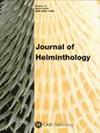A field study of natural infections in three freshwater snails with Fasciola hepatica and/or Paramphistomum daubneyi in central France
IF 1.3
3区 生物学
Q4 PARASITOLOGY
引用次数: 0
Abstract
Natural infections of three freshwater snails with对法国中部三种淡水蜗牛自然感染肝吸虫和/或达布尼副蜗牛的实地研究
在 1996 年和 1997 年的两个时期(6 月至 7 月和 9 月至 10 月),对位于维埃纳省和上维埃纳省(法国中部)、反刍动物肝吸虫感染率较低的 18 个农场的三种淡水蜗牛的肝吸虫和/或大蜗牛副嗜血杆菌自然感染情况进行了研究。在 13 个农场的草地上共采集了 1573 只蜗牛和 1421 只蜗牛,蜗牛高度均在 6 毫米以上,并在实验室条件下进行了解剖。每种蜗牛都发现了单一或同时感染 F. hepatica 和/或 P. daubneyi 的蜗牛。在L. truncatula中,肝吸虫的全球自然感染率(6-7月为3.8%,9-10月为3.6%)明显高于P. daubneyi的感染率(分别为1.1%和0.8%)。在 L. glabra 中,F. hepatica 感染的总体流行率(每个调查期为 0.4%)明显低于 L. truncatula,而 P. daubneyi 感染的流行率之间没有明显差异。在其他五个没有发现 L. truncatula 的农场的草地上,共收集到 2721 个直径至少为 4 毫米的 Planorbis leucostoma。在每个调查期间,这些鳞栉鱼自然感染 F. hepatica 的总体发病率为 0.4%。与法氏囊病相反,在维埃纳省和上维埃纳省的所有农场中,并没有发现感染 P. daubneyi 的蜗牛。在酸性土壤的沼泽草地上发现了蜗牛与 F. hepatica 和/或 P. daubneyi 的自然单发或并发感染,以及 P. leucostoma 与 F. hepatica 的自然感染。
本文章由计算机程序翻译,如有差异,请以英文原文为准。
求助全文
约1分钟内获得全文
求助全文
来源期刊

Journal of Helminthology
生物-动物学
CiteScore
2.80
自引率
12.50%
发文量
127
审稿时长
3 months
期刊介绍:
Journal of Helminthology publishes original papers and review articles on all aspects of pure and applied helminthology, particularly those helminth parasites of environmental health, medical or veterinary importance. Research papers on helminths in wildlife hosts, including plant and insect parasites, are also published along with taxonomic papers contributing to the systematics of a group. The journal will be of interest to academics and researchers involved in the fields of human and veterinary parasitology, public health, microbiology, ecology and biochemistry.
 求助内容:
求助内容: 应助结果提醒方式:
应助结果提醒方式:


